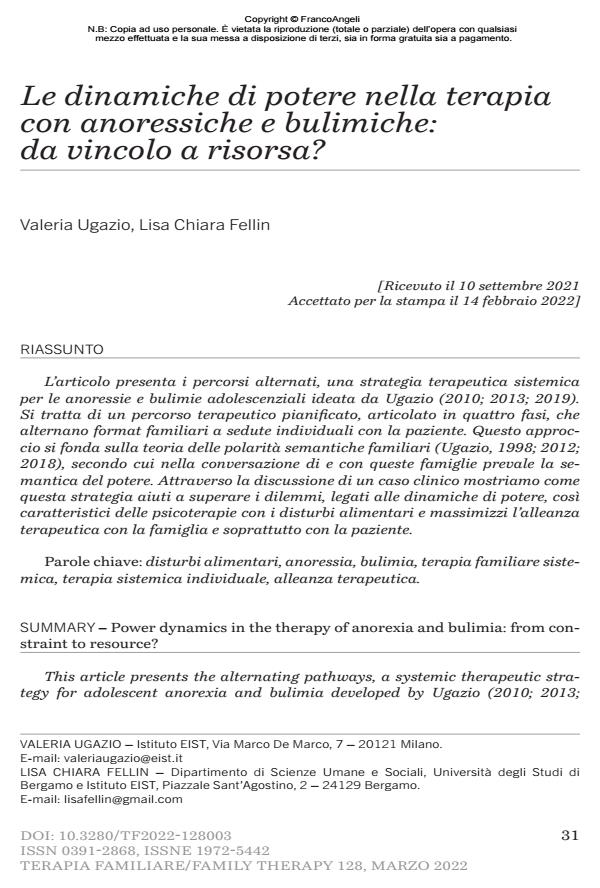Le dinamiche di potere nella terapia con anoressiche e bulimiche: da vincolo a risorsa?
Titolo Rivista TERAPIA FAMILIARE
Autori/Curatori Valeria Ugazio, Lisa Chiara Fellin
Anno di pubblicazione 2022 Fascicolo 2022/128
Lingua Italiano Numero pagine 24 P. 31-54 Dimensione file 664 KB
DOI 10.3280/TF2022-128003
Il DOI è il codice a barre della proprietà intellettuale: per saperne di più
clicca qui
Qui sotto puoi vedere in anteprima la prima pagina di questo articolo.
Se questo articolo ti interessa, lo puoi acquistare (e scaricare in formato pdf) seguendo le facili indicazioni per acquistare il download credit. Acquista Download Credits per scaricare questo Articolo in formato PDF

FrancoAngeli è membro della Publishers International Linking Association, Inc (PILA)associazione indipendente e non profit per facilitare (attraverso i servizi tecnologici implementati da CrossRef.org) l’accesso degli studiosi ai contenuti digitali nelle pubblicazioni professionali e scientifiche
L’articolo presenta i percorsi alternati, una strategia terapeutica sistemica per le anoressie e bulimie adolescenziali ideata da Ugazio (2010; 2013; 2019). Si tratta di un percorso terapeutico pianificato, articolato in quattro fasi, che alternano format familiari a sedute individuali con la paziente. Questo approccio si fonda sulla teoria delle polarità semantiche familiari (Ugazio, 1998; 2012; 2018), secondo cui nella conversazione di e con queste famiglie prevale la semantica del potere. Attraverso la discussione di un caso clinico mostriamo come questa strategia aiuti a superare i dilemmi, legati alle dinamiche di potere, così caratteristici delle psicoterapie con i disturbi alimentari e massimizzi l’alleanza terapeutica con la famiglia e soprattutto con la paziente.
Parole chiave:disturbi alimentari, anoressia, bulimia, terapia familiare sistemica, terapia sistemica individuale, alleanza terapeutica.
- Triadische Interaktionen zwischen erlebter und erzählter Geschichte Valeria Ugazio, Lisa Fellin, in Familiendynamik /2026 pp.50
DOI: 10.21706/fd-51-1-50 - The Planned Alternating Pathways: a flexible protocol for working with anorexic and bulimic adolescents and their families Valeria Ugazio, Lisa Chiara Fellin, in Frontiers in Psychology 1603246/2025
DOI: 10.3389/fpsyg.2025.1603246 - Systemic relational therapy for eating disorders: analysis of family characteristics by means of the SCORE-15 Amanda Bellocci, Giulia Monnetti, Luigi Schepisi, Emanuele Basili, Gianmarco Manfrida, Daniela Tortorelli, in Frontiers in Child and Adolescent Psychiatry 1669051/2025
DOI: 10.3389/frcha.2025.1669051
Valeria Ugazio, Lisa Chiara Fellin, Le dinamiche di potere nella terapia con anoressiche e bulimiche: da vincolo a risorsa? in "TERAPIA FAMILIARE" 128/2022, pp 31-54, DOI: 10.3280/TF2022-128003